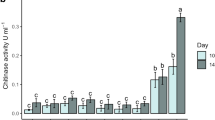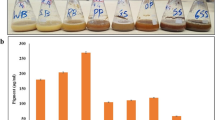Abstract
Antrodia camphorata is a well-known Chinese medicinal mushroom that protects against diverse health-related conditions. Submerged fermentation of A. camphorata is an alternative choice for the effective production of bioactive metabolites, but the effects of nutrition and environment on mycelial morphology are largely unknown. In this study, we show that A. camphorata American Type Culture Collection 200183 can form arthrospores in the end of liquid fermentation. Different morphologies of A. camphorata in submerged culture were analyzed using scanning electron microscopy. The optimal carbon and nitrogen sources for sporulation were soluble starch and yeast extract. We found that a carbon-to-nitrogen ratio (C/N) of 40:1, MgSO4 (0.5 g/l), KH2PO4 (3.0 g/l), an initial pH 5.0, and an inoculum size of 1.5 × 105 spores/ml led to maximum production of arthroconidia. Our results will be useful in the regulation and optimization of A. camphorata cultures for efficient production of arthroconidia in submerged culture, which can be used as inocula in subsequent fermentation processes.

Similar content being viewed by others
References
Adams TH, Wieser JK, Yu JH (1998) Asexual sporulation in Aspergillus nidulans. Microbiol Mol Biol Rev 62:35–54
Ao ZH, Xu ZH, Lu ZM, Xu HY, Zhang XM, Dou WF (2009) Niuchangchih (Antrodia camphorata) and its potential in treating liver diseases. J Ethnopharmacol 121:194–212
Barrera CR (1986) Formation and germination of fungal arthroconidia. Crit Rev Microbiol 12:271–292
Bizukojc M, Ledakowicz S (2006) A kinetic model to predict biomass content for Aspergillus niger germinating spores in the submerged culture. Process Biochem 41:1063–1071
Bizukojc M, Ledakowicz S (2010) The morphological and physiological evolution of Aspergillus terreus mycelium in the submerged culture and its relation to the formation of secondary metabolites. World J Microbiol Biotechnol 26:41–54
Chang TT, Chou WN (1995) Antrodia cinnamomea sp. nov. on Cinnamomum kanehirai in Taiwan. Mycol Res 99:756–758
Chang TT, Chou WN (2004) Antrodia cinnamomea reconsidered and A. salmonea sp. nov. on Cunninghamia konishii in Taiwan. Bot Bull Acad Sin 45:347–352
Chang TT, Wang WR (2005) Basidiomatal formation of Antrodia cinnamomea on artificial agar media. Bot Bull Acad Sin 46:151–154
Chang CY, Lee CL, Pan TM (2006) Statistical optimization of medium components for the production of Antrodia cinnamomea AC0623 in submerged culture. Appl Microbiol Biotechnol 72:654–661
Chen TI, Chen CC, Lin TW, Tsai YT, Nam MK (2011) A 90-day subchronic toxicological assessment of Antrodia cinnamomea in Sprague–Dawley rats. Food Chem Toxicol 49:429–433
Du YC, Wu TY, Chang FR, Lin WY, Hsu YM, Cheng FT, Lu CY, Yen MH, Tsui YT, Chen HL, Hou MF, Lu MC, Wu YC (2012) Chemical profiling of the cytotoxic triterpenoid-concentrating fraction and characterization of ergostane stereo-isomer ingredients from Antrodia camphorata. J Pharmaceut Biomed 58:182–192
Evans HC (2002) Biological control of weeds. In: Kempken F (ed) Mycota XI. Agricultural applications. Springer, Berlin Heidelberg, pp 135–152
Fazenda ML, Seviour R, McNeil B, Harvey LM (2008) Submerged culture fermentation of “higher fungi”: the macrofungi. Adv Appl Microbiol 63:33–103
Fischer R, Kües U (2006) Asexual sporulation in mycelial fungi. In: Kües U, Fischer R (eds) The mycota. Growth, differentiation and sexuality, 2nd edn. Springer, Berlin Heidelberg, pp 261–290
Geethangili M, Tzeng YM (2009) Review of pharmacological effects of Antrodia camphorata and its bioactive compounds. Evid Based Complement Alternat Med 2011:1–17
Gögus N, Tari C, Oncü S, Unluturk S, Tokatli F (2006) Relationship between morphology, rheology and polygalacturonase production by Aspergillus sojae ATCC 20235 in submerged cultures. Biochem Eng J 32:171–178
Jackson MA, Schisler DA (1992) The composition and attributes of Colletotrichum truncatum spores are altered by the nutritional environment. Appl Environ Microbiol 58:2260–2265
Kertesz-Chaloupková K, Walser PJ, Granado JD, Aebi M, Kües U (1998) Blue light overrides repression of asexual sporulation by mating type genes in the basidiomycete Coprinus cinereus. Fungal Genet Biol 23:95–109
Kim HO, Lim JM, Joo JH, Kim SW, Hwang HJ, Choi JW, Yun JW (2005) Optimization of submerged culture condition for the production of mycelial biomass and exopolysaccharides by Agrocybe cylindracea. Bioresour Technol 96:1175–1182
Lin ES, Chen YH (2007) Factors affecting mycelial biomass and exopolysaccharide production in submerged culture of Antrodia cinnamomea using complex media. Bioresour Technol 98:2511–2517
Lin ES, Sung SC (2006) Cultivation conditions influence exopolysaccharide production by the edible Basidiomycete Antrodia cinnamomea in submerged culture. Int J Food Microbiol 108:182–187
Lu ZM, Tao WY, Zou XL, Fu HZ, Ao ZH (2007) Protective effects of mycelia of Antrodia camphorata and Armillariella tabescens in submerged culture against ethanol-induced hepatic toxicity in rats. J Ethnopharmacol 110:160–164
Lu ZM, Tao WY, Xu HY, Lim J, Zhang XM, Wang LP, Chen JH, Xu ZH (2011a) Analysis of volatile compounds of Antrodia camphorata in submerged culture using headspace solid-phase microextraction. Food Chem 127:662–668
Lu ZM, Lei JY, Xu HY, Shi JS, Xu ZH (2011b) Optimization of fermentation medium for triterpenoid production from Antrodia camphorata ATCC 200183 using artificial intelligence-based techniques. Appl Microbiol Biotechnol 92:371–379
Shih IL, Pan K, Hsieh C (2006) Influence of nutritional components and oxygen supply on the mycelial growth and bioactive metabolites production in submerged culture of Antrodia cinnamomea. Process Biochem 41:1129–1135
Shu CH, Lung MY (2004) Effect of pH on the production and molecular weight distribution of exopolysaccharide by Antrodia camphorata in batch cultures. Process Biochem 39:931–937
Sun MH, Liu XZ (2006) Carbon requirements of some nematophagous, entomopathogenic and mycoparasitic hyphomycetes as fungal biocontrol agents. Mycopathologia 161:295–305
Walther G, Garnica S, Weiss M (2005) The systematic relevance of conidiogenesis modes in the gilled Agaricales. Mycol Res 109:525–544
Wolken WAM, Tramper J, van der Werf MJ (2003) What can spores do for us? Trends Biotechnol 21:338–345
Wu SH, Ryvarden L, Chang TT (1997) Antrodia cinnamomea (“Niu-Chang-Chih”), new combination of a medicinal fungus in Taiwan. Bot Bull Acad Sin 38:273–275
Wu SH, Yu ZH, Dai YC, Chen CT, Su CH, Chen LC, Hsu WC, Hwang GY (2004) Taiwanofungus, a polypore new genus. Fungal Sci 19:109–116
Yang FC, Huang HC, Yang MJ (2003) The influence of environmental conditions on the mycelial growth of Antrodia cinnamomea in submerged cultures. Enzyme Microb Technol 33:395–402
Zang M, Su QH (1990) Ganoderma comphoratum, a new taxon in genus Ganoderma from Taiwan, China. Acta Bot Yunnanica 12:395–396
Zhang WX, Zhong JJ (2010) Effect of oxygen concentration in gas phase on sporulation and individual ganoderic acids accumulation in liquid static culture of Ganoderma lucidum. J Biosci Bioeng 109:37–40
Zhao W, Xu JW, Zhong JJ (2011) Enhanced production of ganoderic acids in static liquid culture of Ganoderma lucidum under nitrogen-limiting conditions. Bioresour Technol 102:8185–8190
Acknowledgments
This work was supported by the grants from the Natural Science Foundation of Jiangsu Province, China (grant no. BK2010142), National High-Tech Program of China (grant no. 2007AA021506), Fundamental Research Funds for the Central Universities (grant nos. JUSRP211A42 and JUSRP211A43), Industry-Academia Cooperation Innovation Fund Project of Jiangsu Province, China (grant no. BY2012052), and National Natural Science Foundation of China (grant no. 31201020).
Author information
Authors and Affiliations
Corresponding author
Additional information
Yan Geng and Zhe He contributed equally to this work.
Rights and permissions
About this article
Cite this article
Geng, Y., He, Z., Lu, ZM. et al. Antrodia camphorata ATCC 200183 sporulates asexually in submerged culture. Appl Microbiol Biotechnol 97, 2851–2858 (2013). https://doi.org/10.1007/s00253-012-4513-2
Received:
Revised:
Accepted:
Published:
Issue Date:
DOI: https://doi.org/10.1007/s00253-012-4513-2




